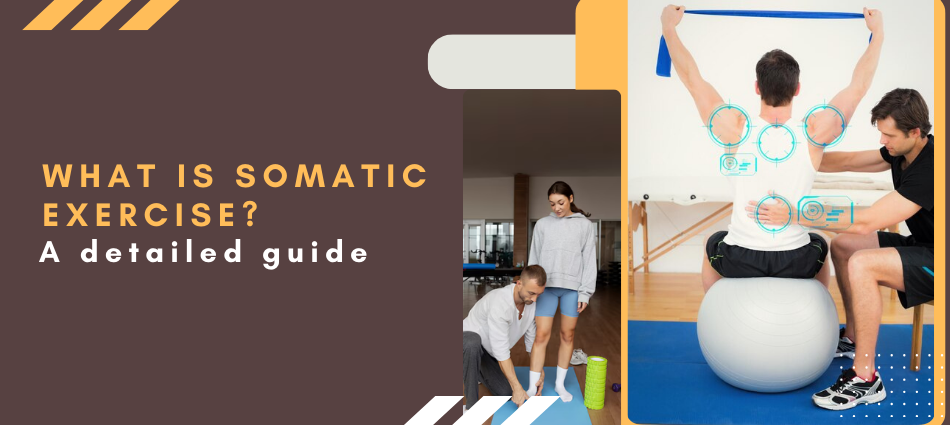What is somatic exercise? A detailed guide
Somatic exercise is a gentle way of moving your body with awareness. Instead of focusing on how a movement looks, you focus on how it feels. These exercises help release muscle tension, improve body control, and reduce stress. They involve slow, mindful movements that reconnect you with your body. Unlike regular stretching, somatic exercises are about sensing and adjusting movements rather than reaching a specific pose. They are simple, require no special training, and can be done daily to support overall well-being.
History of somatic exercise
The term “somatic” was introduced by Thomas Hanna in the 1970s to describe movement practices that focus on body awareness. He believed that many physical issues, like stiffness and pain, could be improved by consciously controlling muscles and nerves. Somatic exercises have roots in ancient Eastern practices like tai chi and qi gong but became more popular in the Western world over the last 50 years. Today, these exercises are widely used for pain relief, relaxation, and better movement. Many medical experts and fitness programs now include somatic exercises as part of overall health and recovery.
What are somatic exercises?
Somatic exercises are movements that focus on how your body feels rather than how it looks. They help improve body awareness, release tension, and create better movement patterns.
There are different types of somatic exercises, including:
- Rolfing – deep tissue movement therapy
- Alexander Technique – posture and alignment training
- Feldenkrais Method – gentle movements to improve flexibility
- Laban Movement Analysis – understanding body motion
Other common activities like dance, yoga, Pilates, and aikido can also be somatic if done with mindfulness. Unlike regular workouts, the goal is not to push harder but to move in a way that teaches you about your body. These exercises can also help process emotions and reduce stress.
Benefits of somatic exercise
- Helps release muscle tension and stiffness.
- Improves posture and body alignment.
- Increases flexibility and range of motion.
- Enhances body awareness and coordination.
- Reduces stress and promotes relaxation.
- Supports better movement patterns.
- Helps manage chronic pain and discomfort.
- Encourages a deeper connection between mind and body.
- Can improve balance and stability.
- Supports emotional well-being and self-expression.
3 Simple Somatic Stretches for Beginners
1. Body Awareness Check
Stand up straight with your feet firmly on the ground. Pay attention to how your feet press into the floor. Try tensing and relaxing your foot muscles. Take slow, deep breaths, noticing how your belly moves. Scan your body from head to toe and feel any tight areas. Focus on relaxing those muscles.
2. Neck Relaxation Stretch
Stand with your feet planted firmly. Let your head drop forward slowly, as far as it feels comfortable. Notice any tightness in your neck, shoulders, or upper back. Pay attention to how your body adjusts to the stretch. Breathe deeply and try to release any tension you feel.
3. Lower Back Release
Lie on your back with your feet flat and knees bent. Breathe in and notice how your belly and lower back move. Gently arch your back, pressing your hips and feet into the floor. Hold for a moment, then slowly flatten your back against the ground. Repeat slowly while focusing on any tight spots in your lower back.
Are there any side effects of somatic exercise?
Somatic exercises are gentle and safe for most people. However, some may feel discomfort if they move too quickly or force a stretch. Beginners might find it hard to focus on body awareness at first. If done incorrectly, it may not relieve tension as expected. People with injuries or medical conditions should check with a doctor before starting. Listening to your body and moving slowly can help avoid any issues.
How to do somatic exercise at home?
- Run warm or cool water over your hands and notice the feeling.
- Move your body in ways that feel natural and comfortable.
- Focus on your breathing, taking slow and deep breaths.
- Tense and relax different muscles from your feet to your head.
- Name objects around you to stay present and aware.
- Move slowly and pay attention to how your body feels.
Conclusion
Somatic exercises offer a simple way to improve body awareness, release tension, and promote relaxation. Unlike traditional workouts, they focus on how movements feel rather than how they look. These exercises can help with flexibility, posture, and stress relief while supporting overall well-being. Whether you are looking to ease muscle stiffness, improve coordination, or connect with your body on a deeper level, somatic exercises can be a valuable addition to your daily routine. By practicing them regularly and listening to your body, you can enjoy their long-term benefits for both physical and emotional health.
FAQs
1. Who can benefit from somatic therapy?
Somatic therapy is helpful for people who want to feel more connected to their bodies and emotions. It uses grounding and mindfulness to bring you into the present moment. This can be useful for those dealing with stress, anxiety, or past trauma.
2. What somatic exercises help with weight loss?
Some somatic exercises that may support weight loss include body-mind centering, the Alexander technique, the Feldenkrais method, and Laban movement analysis. These focus on mindful movement, better posture, and body awareness, which can improve overall fitness.
3. Do somatic exercises really work?
There is no solid proof yet, but some studies suggest that somatic exercises can help with pain relief, tension release, and smoother movement. More research is needed to fully understand their benefits.




